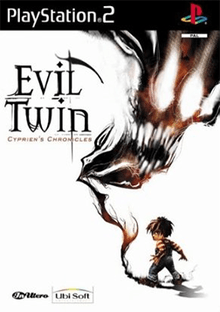Evil Twin: Cyprien's Chronicles
Evil Twin: Cyprien's Chronicles is a platform game developed by Ubi Soft and In Utero for the Dreamcast, PlayStation 2, and Windows.
| Evil Twin: Cyprien's Chronicles | |
|---|---|
 | |
| Developer(s) | In Utero |
| Publisher(s) | Ubi Soft (PS2, Windows) BigBen Interactive (DC) |
| Composer(s) | Bertrand Eluerd |
| Platform(s) | Dreamcast, PlayStation 2, Windows |
| Release |
|
| Genre(s) | Platformer |
| Mode(s) | Single-player |
Gameplay
The game takes control over a young orphan called Cyprien, who is taken to a nightmarish world and possesses the ability to transform into a Super version of himself. His alter-ego, Supercyp aids him in his journey to Loren Darith to free his teddy bear, Lenny.
Story
The story begins with Cyprien at his orphanage staring at his reflection of himself in the bathroom. His buddy, Dave enters the room and tells him to come out into the main room. It is Cyprien's birthday. Cyprien's other friends, Vince, Joey, and Steve are waiting for him. He enters the room, completely apathetic and depressed. Steve explains that Cyprien's parents had died on his birthday and Cyprien leaves the room.
He is greeted by Lenny, his teddy bear and imaginary friend. Cyprien, already irritated with the flood of questions from his friends, becomes hysterical and tells Lenny that he is only a toy, and condemns Lenny's world (Undabed) to oblivion.
Cyprien begins to laugh and the room darkens, Lenny disappears and Cyprien's friends are being grabbed by dark shadowy tentacles. After the havok subsides, Cyprien awakens from his unconscious state and cannot find Lenny. He is then teleported to Undabed, and is greeted by Wilbur, a friend of Lenny's.
Wilbur then explains that a great wave swept everything away and a massive tower (Loren Darith) appeared, and in that tower lived a hideous creature named the "Master". The Master manipulated the people of Undabed by erasing all traces of the past and entrusted a key to the people of Demi Island, called "The Great Zippete".
Lenny went to Demi Island to obtain that very key, and was nearly able to get it. However, the Master's troops arrested Lenny before he could get his hands on it.
The Master took control of Demi Island by convincing the Demi people (whose bodies are split in two) that their bodies were once whole, and took away the Zippete and lied that it was vestige of when the Demi's where whole. The Master then divided the Zippete into four pieces, each scattered on 4 different worlds. It is then up to Cyprien to acquire the 4 parts of the Great Zippete, and free Lenny.
Development
The game was originally intended to be released in late 1999 under the title of "Evil Twin" but was later delayed due to financial reasons. A gameplay video of the game was available on the Sega Dreamcast "Dreamon Collection 4" demo disc.
Release
Evil Twin: Cyprien's Chronicles was released in Europe only, it was one of the last PAL Dreamcast released games with a version distributed by BigBen Interactive. The game was exclusive to Game Stores Group. It was also released for PlayStation 2 in December 2001.[1]
Soundtrack
The soundtrack was unreleased until 2010 when it was released under Bertrand Eluerd bandcamp, compiled into three volumes. The first two volumes feature the in-game music, the third volume is a collection of leftovers, demos and a couple of tracks from the aborted Evil Twin II project.[2]
Reception
Evil Twin: Cyprien's Chronicles received mixed reviews from various review sites. The game was praised for its level design, art direction and music by composer Bertrand Eluerd but the game has also been criticized for the poor controls. The Sega Dreamcast saw only a release in the PAL territory (Europe, Hong Kong, Australia and New Zealand).[3]
References
- "Game details". Evil Twin: Cyprien's Chronicles. Giant Bomb. Retrieved 22 May 2018.
- "Soundtrack". Evil Twin: Cyprien's Chronicles. Bandcamp. Retrieved 4 September 2019.
- "IGN". Evil Twin: Cyprien's Chronicles. IGN. Retrieved 5 September 2019.